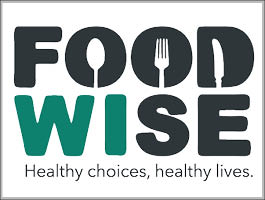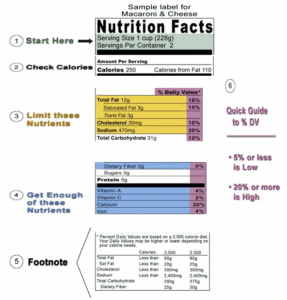Frequently Asked Questions
1. Q . How long can I keep meat in the refrigerator?
Refrigerate fresh meat, chicken and turkey and use it within 5 days. Refrigerate fresh fish and use it within 2 days.
Most sliced deli meat will only keep in the refrigerator for 2 days before quality deteriorates.
2. Q. How do you know if a grain product is a whole grain?
A. Read the ingredient list on the food label. For many whole-grain products, the words “whole” or “whole grain” will appear before the grain’s name on the ingredient’s list. The whole grain should be the first ingredient listed. Wheat flour, enriched flour, and degerminated cornmeal are not whole grains. Another tip for finding whole grains is to look for the whole-grain health claim—“Diets rich in whole-grain foods and other plant foods and low in total fat, saturated fat, and cholesterol may help reduce the risk of heart disease and certain cancers”—on food product labels. Foods that bear the whole- grain health claim must:
- Contain 51 percent or more whole grains by weight
- Be low in fat, saturated fat, trans fat, and cholesterol
Some whole-grain choices:
1 slice whole-grain bread (such as 100% whole-wheat bread)
1 ounce ready-to-eat, whole-grain cereal (about 1 cup wheat flakes)
1⁄2 cup cooked whole-grain cereal, brown rice, or whole-wheat pasta
5 whole-grain crackers
3 cups popped popcorn
3. Q. Is it okay to feed my child the same foods every day?
A. It is okay. Eventually, they may get bored. Children go through what we call jags. That’s when they only want to eat the same thing every day, like macaroni and cheese. As long as the foods are nutritious it is okay. We suggest offering foods that they like along with the new foods. Set an example by eating it yourself and do not become a short order cook (separate meals for each person you cook for),but rather prepare meals that have something that everyone likes and allow the child to choose the food/s he/she would prefer to eat.
Remember, it is also important never to force a child to eat. If they choose not to eat let them know that they will still have to sit with the family and that they will not be able to eat again until the next scheduled meal. Always keep in mind that just because you like a particular food, it doesn’t mean that your child will automatically like it.
4. Q. How can I use the label to make heart-healthy food choices?
A. The Nutrition Facts panel can help you choose foods lower in saturated fat, trans fat, calories and cholesterol.
The information in the main or top section (see #1-4 and #6 on the sample nutrition label below), can vary with each food product; it contains product-specific information (serving size, calories, and nutrient information). The bottom part (see #5 on the sample label below) contains a footnote with Daily Values (DVs) for 2,000 and 2,500 calorie diets. This footnote provides recommended dietary information for important nutrients, including fats, sodium and fiber. The footnote is found only on larger packages and does not change from product to product.
In the following Nutrition Facts label we have colored certain sections to help you focus on those areas that will be explained in detail. You will not see these colors on the food labels of products you purchase.
5. Q. My child is a picky eater, what are some tips on feeding them?
A. Remember a parent is responsible for what foods are offered and when meals & snacks are eaten. Give the child the option to decide their own preferences. Some tips to consider:
- Keep about two hours between snacks and meals
- Give very small servings – let the child ask for more
- Offer choices – let the child help plan a meal
- Set a good example
- Serve new foods when the child is hungry, well-rested and happy
- Make food interesting – children like variety in color and texture
- Avoid arguing about food with a child
6. Q. How can bread be labeled as both white and whole wheat? Is white whole-wheat bread really nutritious?
A. It may seem like it doesn’t add up, but the answer is in the labeling. White whole-wheat bread is made with whole grains, just as in regular whole-wheat bread. White whole-wheat bread is also nutritionally similar to that of regular whole-wheat bread.
The difference between white whole-wheat bread and regular whole-wheat bread is in the type of wheat used. White whole-wheat bread is made with white wheat, which lacks bran color and has a milder flavor. Regular whole-wheat bread is made with red wheat, which is darker in color, has a slightly bitter taste and a coarser texture.
When selecting any kind of bread, read the label carefully. Choose breads that list a “whole” grain as the first ingredient, such as whole wheat, white whole wheat or whole oats. If the label doesn’t say “whole” first, it isn’t a whole-grain product. For example, a product label may simply say “white wheat” or “enriched wheat flour” which is not the same as white whole-wheat bread. Always remember to make half your grains whole grains.






